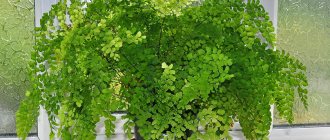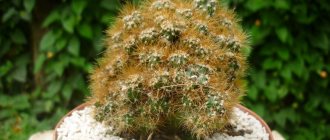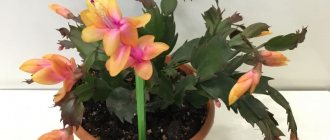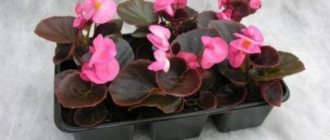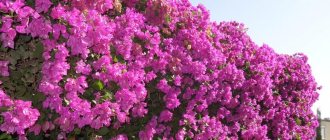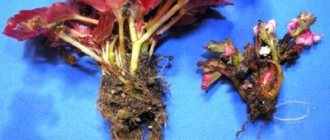Recently, tuberous begonia is increasingly winning the hearts of flower growers. The popularity of these wonderful plants is explained by their varied colors and abundant, long-lasting flowering. Even novice gardeners can grow begonia, as it is quite unpretentious.
Begonia was discovered in the 17th century during an expedition to Haiti. The description of the plant was made by C. Linnaeus and named it in honor of the governor of Santo Domingo, a great collector of plants - Michel Begon.
In Russia, some types of begonias have long been grown as indoor plants. People often called it “Eagle Wing”, and after the French army left Moscow in 1812, begonia began to be called “Napoleon’s Ear”, since the underside of the leaves of some varieties of begonia resembles a frostbitten ear.
There is now quite a large selection of varieties of these wonderful perennial herbaceous plants that form tubers on sale. Their flowers sometimes resemble roses or camellias, with white, yellow, pink or red colors.
Currently, tuberous begonias are divided into three groups:
- large-flowered double,
- medium-flowered double,
- small-flowered (double and simple).
Begonias are perfect for decorating flower beds and flowerpots. The wide leaves of these plants and bright flowers create an excellent decorative effect. Tuberous begonias combine harmoniously with many low annual flowering and decorative foliage plants. For example, I really like the combination of begonia with cream flowers and blue heliotrope. Flowerpots with blooming begonias will undoubtedly decorate your balcony, terrace or veranda. Vases and flowerpots with ampelous forms of tuberous begonia look very impressive and elegant. In addition, with proper care, they bloom almost continuously all summer and until frost.
Tuberous begonias are short-day plants. Taking into account this feature, it is advisable to completely shade plants that are lagging behind in development in July for 3-4 weeks with opaque material from approximately 19 to 10 hours. This helps to increase the size of the tubers by about one and a half times. Experts recommend doing the same with cuttings. In addition, the ripening of tubers is facilitated by the removal of flowers.
It must be taken into account that begonias do not tolerate overdrying and can shed leaves if there is a lack of moisture, so it is advisable to add hydrogel to the ground or plant them in spacious containers.
Lighting
Decorative begonias love sunlight and will delight you with their picturesque colors when you place them on a south-facing window.
It is advisable to grow flowering begonias at home on windows in eastern and western directions.
Begonias love freedom and even illumination; when placing them next to other plants, leave space between them. Make sure that neighbors do not shade the flower, otherwise it will suffer.
In autumn-winter, compensate for the lack of lighting with special lamps.
Watering
Begonia is a plant with increased air humidity requirements. Information on how to water a flower will not be superfluous for plant connoisseurs.
To water the flower, use settled water at room temperature. Make sure that the water does not stagnate in the pot, otherwise the roots may rot.
Decorative deciduous varieties with fibrous roots should be watered abundantly during the period of active growth.
Tuberous varieties require moderate watering. It is necessary to re-moisten the soil only after the soil in the pot is half dry.
If begonia grows in a room with dry air, then its tips will begin to dry out over time, and the beautiful flowers will dry out. Correct the situation immediately. Install an air humidifier next to the flowers or purchase a tray with a grate under which wet expanded clay will be placed.
Place the pots with begonias on the grid, and the moisture evaporated from the expanded clay will allow the begonias to grow in comfortable conditions.
Features of Rex begonia
Royal begonia is a member of the Begoniaceae family, which includes more than 1,600 species. Moreover, such a large family received its name in honor of Michel Begon, who was a Frenchman.
The plant has spectacular asymmetrical leaf plates with a carved edge. They can be painted in a variety of shades and their combinations (depending on the variety). Begonia has a fleshy, voluminous rhizome that rises slightly above the surface of the substrate.
During the flowering period, small unsightly flowers appear on the bush. Since they have a nondescript appearance, they do not represent any decorative value. Therefore, Rex begonia is grown as an ornamental foliage plant.
Top dressing
The domestic Begonia plant loves fertilizers and will thank you with abundant and bright flowering. It is recommended from mid-spring to mid-autumn to water the plants once every two weeks with a mineral-vitamin complex for flowering plants.
In specialized stores you can choose a suitable complex for your plants. For flowering species, choose phosphorus-potassium fertilizers; for decorative deciduous species, fertilizers with a high nitrogen content are suitable.
From November to March, flower fertilization should be stopped and begonias should not be prevented from resting before the next blooming year.
How to make it bloom
As a rule, Rex begonia is grown as an ornamental foliage crop. However, some gardeners definitely want to see it bloom. For this, the plant is provided with optimal conditions:
- A large amount of bright diffused light.
- Fertile, well-drained soil mixture.
- Water the bush moderately and in a timely manner. Make sure that the substrate in the container does not dry out.
If all these conditions are met, the bush will definitely bloom. But still, sometimes it happens that the bush receives good care, but does not bloom. This may be due to the fact that he:
- feels an acute lack of nutrients;
- is ill;
- planted in an overly cramped pot or it has not been replanted for a long time, and the root system has already mastered the entire earthen ball.
The soil
To plant begonias, choose loose soil with a slightly acidic or neutral environment. In flower shops there are special soils for Begoniaceae.
If you prefer to prepare the soil for plants yourself, then stick to this composition:
- 3 parts leaf soil.
- 1 part peat.
- 1 part humus.
- 1 part coarse sand.
Before planting, it is recommended to disinfect the soil, both purchased and independently prepared - freeze, steam, spill with a solution of hot potassium permanganate or a solution of phytosporin.
Flower container
The optimal container for the plant is wide and low. The diameter of the pot should be no more than 4 cm larger than the root system of the begonia. If you choose a larger pot, you risk that the plant will bloom later.
The material from which the flowerpot is made also matters. The best solution for begonias is a ceramic pot.
Selection of planting material
I buy new tubers immediately after they go on sale. As a rule, this is mid-January - early February. At first glance it may seem that I am in a hurry to buy. But as experience shows, at this time there is a much greater chance of choosing high-quality planting material, and at home trying to create optimal conditions for storage, which, unfortunately, cannot always be seen in retail outlets. There, often by spring almost completely dried and non-viable tubers are sold.
When purchasing, it is better to choose young, round tubers with a diameter of 5-6 cm.
Before planting, I use wet sawdust or moss to store purchased material. I usually store it in the refrigerator until early March.
Landing
Fill the prepared flowerpot one third with expanded clay; to prevent fungal diseases, add a small layer of charcoal. Pour some of the prepared soil on top. After placing the begonia in the prepared pot, carefully add the missing soil and water the plant generously.
It is best to plant begonias in the spring - March - April. At this time, the day is already long enough and the level of lighting is sufficient for the harmonious development of the plant.
If you are preparing tuberous begonias for planting, you must first germinate them in a bright, damp place at a temperature of 16-18ºC.
Top 10 popular varieties
The most popular varieties include:
- The Party Dress variety is a tuberous variety that has a spectacular dazzling fiery palette. The inflorescences of the variety are quite large and terry. The color has a harmonious transition. The dense inflorescences of the hybrid consist of flowers, the edges of which are endowed with ruffled outlines. The outer part of the petals is wide. Closer to the center the petals narrow. Their cruciform structure becomes clearer. The apricot-orange hue of the flowers looks very rich. The extreme part of the petal is painted with a thin reddish stripe, which is slightly blurred. The resulting contrast conveys the richness and warmth of the shade.
- Variety Picotee Yellow-Red. The main difference between this plant variety is its two-color color. Picotee Yellow-Red, despite its compact size, has lush flowering. The massiveness and density of the variety, whose height rarely exceeds 35 cm, is achieved thanks to shortened peduncles. The diameter of the flowers is within 8-9 cm. Thick double flowers look very elegant and become a real decoration of the yard. Picotee Yellow-Red petals look very unusual due to their apricot-melon shades with dark red edges. Densely arranged flowers merge into one motley spot. The greenery of the plant is painted in bright, cool tones, making the flowers look as impressive as possible.
- Variety Camelia. Tuberous is distinguished by its unique shape of petals and dense double flowers that resemble camellia. The height of the bush reaches 28-30 cm. Small foliage emphasizes the large size of the flowers, the diameter of which is in the range of 9-12 cm. The edges of the begonia are painted in white shades. Uneven spots fade into rich, dark pink bases. This watercolor painting of the classic flower shape looks very attractive.
Variety Party Dress
- The Marmorata variety vaguely resembles camellia, but differs from it in color. The red edges of the petals blend into a snow-white base in uneven strokes. Due to the variety of flowers, Marmorata is often compared to carnations, which are characterized by similar patterns. The flowering is lush. Marmorata seed can be purchased at any specialty store.
- Variety Samba is a double, large-flowered species that is distinguished by ruffled edges of the petals and bright shades of flowers, which can be orange, white, soft pink, or cream, hot pink, yellow. The diameter of the flowers often reaches 9-10 cm. Densely branching bushes look neat. Due to the shortened peduncles, there is a feeling that the flowers are sitting on the foliage.
- Alcor F1 is a hybrid ampelous medicinal begonia that perfectly purifies the air. Alcor reaches a height of 40-45 cm. The foliage of the plant is dense, but the abundance of flowers that bloom on the bush literally covers all the greenery and creates a bright spot. Alcor flowers reach a diameter of 8 cm. Their elegance and asymmetry attract gardeners. The upper outer petals are colored candy red. Bright pink streaks are clearly visible on the lower outer white petals. At the center of the flowers, the petals are gracefully colored in delicate shades of pink and orange.
- Olomouc This hybrid is an ever-blooming hybrid. The main property of the plant is to reduce the content of staphylococcus in the air. The height of the bush barely reaches 20 cm, the diameter of the white flowers is between 2-3 cm. The dazzling bright foliage and compactness of the dense bush with ideal shapes make Olomouc a popular variety. The flowers of the plant appear artificial from a distance. The round petals bend in such a way that they resemble the brim of a hat. The purity of the lines surprises no less than the bright radiance of the colors of the flowers. The lush ball, which is formed by orange stamens in the center, looks very impressive. Olomouc begins to bloom earlier than other varieties of the plant and delights with its colorful flowers before the onset of the first frost.
Variety Picotee Yellow-Red.
- Lucenets - the petals are endowed with special tenderness. A large bright pink border effectively transitions into a snow-white palette on the two central petals. Lucenets looks fresh, pastoral and very romantic.
- Splendide Ballerina is a compact bush, the height of which is between 25-30 cm. Hundreds of shades are combined in one plant. Large flowers cover slightly reddish, inconspicuous greenery. The diameter of the flowers often reaches 10 cm. Each densely double flower is painted in a salmon, pink, butter yellow, peach, fawn, and apricot palette. The yellow tint gives the flowers a unique appearance. No description will convey all the beauty of the variety.
- Funky Pink is a new variety that is gaining more and more popularity every year. A new form of flowers, reminiscent of a chamomile with narrow petals and uneven doubleness. The thin pinkish peduncle and the elegance of the narrow bright yellow stamens look quite attractive. The foliage of plants of this variety is beautifully pointed, the shoots are quite strong, the flowers are lush and bright.
Variety Marmorata
Plant varieties such as:
- begonia Griffin;
- Begonia Camellia;
- begonia fista;
- begonia Black Prince;
- Credner begonia;
- Begonia Big;
- Begonia Go Go;
- begonia Midnight magic;
- begonia Palomar prince;
- Begonia Tamaya;
- big deluxe;
- Begonia Black Velvet;
- begonia Purple snow;
- Begonia Black fang;
- Begonia Dark ed;
- Begonia Salts mutate;
- Begonia Escargot;
- begonia Green goddess;
Variety Splendide Ballerina
- Begonia Pikoti;
- Miss Malibu begonia;
- Dollar down;
- begonia Maurice amy;
- begonia Raspberry torte;
- Begonia Marmorata;
- Fimbriata;
- Begonia Chloroneura;
- persian Іwirl;
- Crispa;
- Pendula;
- Black Mamba;
- Peter piper begonia;
- Hallelujah;
- Black corduroy;
- Preen gold begonia;
- begonia Frances valentine;
- begonia Raspberry swirl;
- Sal scomet;
- Begonia Sizemoreoe;
- Begonia Black Fang;
- Gloire delorren, which is absolutely easy to care for;
- Begonia Mary Christmas;
- Kane;
- Palomar Prince;
- Begonia Fista.
Begonia bouton de Rose
Transfer
The indoor plant grows quickly and needs periodic replanting. When the roots of the plant begin to peek out from the drainage holes, you need to think about transplanting it into a larger pot.
Water the plant generously to make it easier to free the begonia from the old soil. After freeing, carefully rinse the root part with warm water, remove rotten and damaged roots. To disinfect, leave the roots in a weak antiseptic solution for five minutes. Next, dry the roots and treat fresh cuts with charcoal powder.
Plant the treated plant in a prepared, larger pot, filling the plant up to the upper root collar and watering it generously.
Return the transplanted flower to its place and water it abundantly at first.
Young plants up to 3 years old tolerate transplantation well, but older plants are much worse and can be sick for a long time after transplantation. Experts recommend dividing an adult plant into several parts and planting it in different containers.
Reproduction methods
Leaves and cuttings
Cuttings are the easiest and most common way to propagate Rex begonias. Using a disinfected knife, a leaf or cutting is separated from the parent plant. It is placed in a solution that stimulates root growth. Instead, you can use regular well-settled water. Young roots will appear in just a few days. The cuttings with roots should be planted in a small separate pot.
Propagation by tubers and roots
Inexperienced gardeners should avoid this method of propagation. The fact is that you will definitely need to find a growth bud on the rhizome. However, experienced flower growers often use this particular method of flower propagation. Please note that varietal begonias are not often subjected to division of the root system.
Growing from seeds
Growing begonia from seeds is quite difficult. The seed material is more like dust, so difficulties arise already at the sowing stage. Also, the seeds have low germination. Most often, begonia is grown from seeds by breeders in the process of creating new varieties.
Rest period
Decorative deciduous varieties
Evergreen species of begonias have a weak dormant period. In winter, the plant slows down its active growth and blooms less. It is recommended to reduce feeding of begonias to once a month and reduce watering.
If possible, organize a room for begonias in winter with high humidity and a temperature of around 15-18 degrees. Spray your plants moderately and remove dry and damaged parts in a timely manner to prevent the development of diseases.
Tuberous varieties
From mid-autumn, begonias with tuberous roots begin preparing for hibernation. The leaves on them gradually dry out and die, giving all the useful substances to the nodules for storage. Watering the plant during this period should be reduced and fertilizing should be kept to a minimum.
After the aerial part has completely died off, the pots with begonias should be taken to a dark, cool room with a temperature of 10 to 16 degrees.
It happens that tuberous begonia, like a naughty child, does not want to hibernate. You should not follow the plant’s lead; force it to fall asleep, otherwise you risk being left without flowers in the summer. Reduce watering and trim the above-ground parts of the plant.
If the tuberous begonia grew in open ground in the summer, then do not forget to dig it up in mid-autumn and bring it indoors. Trim the aerial part of the begonia so that 3 cm of the stem remains, dry the tubers for 2 weeks, and then put them in a box, cover with sand and place for storage in a dark room with a temperature of 6-10 degrees.
Pests and diseases
Since royal begonia is unpretentious, gardeners often forget to care for it altogether. And this can cause disease or death of the plant.
Diseases
Often such a flower is affected by gray rot, powdery mildew and bacterial disease. The development of these diseases is usually facilitated by improper watering or infrequent feeding.
Pests
Spider mites, scale insects, thrips or whiteflies most often settle on the bush. To get rid of pests, use insecticidal preparations or folk remedies, for example, a soap solution (prepared from laundry soap). However, remember that most often pests enter the plant from a neighboring bush, so it is recommended to treat all the flowers in the house.
Begonia propagation
There are many ways to propagate your favorite plant. With a little effort, they will be rewarded with a beautiful flowering plant.
Growing from seeds
Begonia seeds are very small. In order to evenly distribute the seeds when planting, it is recommended to mix them with sand or flour. The soil for germinating seeds should be light - equal proportions of peat, sand, leaf soil.
Seed germination should begin from late February to early March. The seeds are evenly distributed over the surface of the prepared substrate and gently moistened with water from a spray bottle. Cover the top of the container with glass or film and place in a warm, well-lit place.
After the seeds begin to germinate, the film must be removed. As a rule, the first shoots should appear within 2-3 weeks. When the small plants grow up and produce three true leaves, they can be plucked.
After 2 months, the grown young plants can be planted in individual pots. Provide quality care at home and young plants will be able to bloom in the first year.
Growing from tubers
Begonia can be propagated by dividing the tuber. This is done in early spring, the tuber is cut into pieces so that the cut part must have a bud.
The sections on the tuber are treated with crushed coal, the tubers are slightly dried and placed in separate containers.
Growing from leaves
For propagation by leaves, you need to choose a healthy and large leaf. The leaf is carefully cut from the mother plant and cuts are made along the veins on the reverse side.
The leaf is carefully placed with its reverse side on the prepared substrate and pressed to the ground. Watering the plant should be done through a tray.
After a few months, roots grow at the cut sites and new plants begin to form. As soon as the children grow up, it is recommended to place them in a separate pot.
Growing from cuttings
The simplest and most effective way to propagate your favorite plant. A cutting with 4 leaves is cut from an adult begonia, its cut is treated with crushed coal and planted in the ground.
The pot with the cuttings is placed in a bright place, which is protected from drafts and direct sunlight. Water the cuttings sparingly; between waterings the soil should dry to a depth of 2 cm.
There is another way to root cuttings - in water, the roots grow within a month. After this, the plant is planted in the ground and provided with proper care indoors.
LiveInternetLiveInternet
Monday, January 25, 2016 23:47 + to quote book _____________________________________________________________________
_________________________________________________________________________ Being interested in indoor plants, I often paid attention to begonia, but before there was not a wide variety of varieties, but now, looking at such beauty, I simply fell in love with this plant! Begonia leaves are of extraordinary beauty, striking in their variety of colors and shapes. Just look how lovely it is! _________________________________________________________________________________ Begonia DS-Vasilisa______________________
Begonia DS-Bird Talker_________________ Pointed, with carved edges, very light leaves covered with pink specks along the veins, a wide pink-lilac border.
Begonias DS-Swan and DS-Arabica Begonia DS-Swan_______________________ Very light leaves, light milky white with a light pink wide border and pink in the center of the leaf. It grows very quickly.
Begonia DS-Marmalade__________________ Delicate, medium-sized silvery leaves are covered with a pink transparent veil. It grows very quickly. Begonia DS-Shower_________________________ Light green leaves slightly curled at the base with a wide dark pink border, and all this is evenly filled with silver shower. Begonia DS-My Joy___________________ Begonia DS-Polka Dot_____________________ Compact shell with dark green-burgundy leaves with an abundance of light peas.
Begonia DS-Cherry in Chocolate ____________ Dark brown, delicious color, leaves with large cherries generously scattered throughout the leaf. The edges of the leaves are even darker. The leaf is slightly curled at the base. Large. Begonia DS-Birth of Fire __________________ Large tricolor leaves are very contrastingly colored: a very dark, almost black central leaf, then a wide edge with red, and the same width edge with silver, after which again a dark, black color forming the edge. Shell. Begonia without a name_______________________ Begonia DS-Cuba and DS-Marmalade Begonia DS-Women's Arms_____________ Bright, glamorous, eye-catching with its colorful outfit. Pointed light leaves with green mesh. The middle of the leaf is bright red and the border is equally red.
Begonia DS-Flirt______________________ Wide textured brown border, brown leaf center. The main area of the leaf is dark red. Begonia DS-Big Heart_______________ Large satiny red leaves in the shape of a heart. The center of the leaf is slightly curled. In the center of the leaf there is a thin brown mesh, and the same mesh along the edges of the sheet. Begonia DS-31 June____________________ Powerful, dense leaves are colored green and red with smoothly changing shades from light to dark. Large peas of pink along a wide green border; dark red, fading into black, wavy edge of the leaf. Dark middle. Shell. Begonia DS-Raspberry________________________ Large and small raspberry peas are densely scattered on a barely translucent light green background, giving rise to a certain texture reminiscent of raspberry pimples. Darker wide border. The base of the leaf is slightly curled. Begonia DS-Carmen__________________________ Satin red leaves, light border with dark green mesh, red, slightly wavy edges. Shell. Begonia DS-Burning Passion_________________ Red satin shell leaves with a wide dark brown border and the same dark center. Begonias DS-Japan and DS-Burning Passion Begonia DS-Japan______________________ Begonia DS-Summer Snow______________________ Summer colors: rich greens, overripe cherries combined with white snow flakes.
Begonia DS-Cat Leopold_____________________
Begonia DS-New Year's Salute_____________ A very bright and variegated shell. Complex colored and beautifully shaped leaves. The wavy leaves with a twisted center are silvery-light green; dark green with a khaki tint appears through the gaps in the ground background; very wide, almost black border with pink polka dots. From the center, dark brown spreads along the veins, smoothly turning into pink.
Begonia DS-Holiday and DS-Gossamer Begonia DS-Holiday______________________ Wide almost black border, center of the same color.
The main field of the leaf is colored chaotically in different colors, in the form of spots of red, dark green and silver of different shapes and sizes. The base of the leaf is slightly curled with a shell. Begonia DS-Carnival________________________ Compact, bright. Bushes well, independently forming a neat bush. By analogy with violets - a small standard. Begonia DS-Swan with DS-Bird Talker and an unnamed seedling ___________________________________________________________________________ Photos by Elena and Pavel Enikeev Pavel and Elena Enikeev are breeders, founders of the Dimetris Club. Dimetris was organized in 2004 and became a center for collecting, breeding and selling Gesneriaceae and other plants. Tags:
begonia indoor plants decorative deciduous begonias varietal begonias selection flowers dimetris hobbies begonias decorative deciduous plants plants
Cited 2 times Liked by: 4 users
Like share
0
Like
- 4
I liked the post - Quoted
- 0
Saved
- Add to quote book
- 0
Save to links
Liked4
0
Useful qualities of a flower
The leaves of the plant contain a large amount of phytoncides. Phytoncides are biologically active substances that are effective against pathogenic bacteria and fungi, in particular staphylococci.
Begonias effectively clean the air of dust, toxic substances and electromagnetic radiation.
Many plant owners have noticed that indoor Begonia flowers help improve immunity and mental activity, reduce fatigue and increase performance. Scientists and writers welcome the presence of this flower in their homes.
The healing effect of the flower has long been proven by herbalists. The green parts of the flower are an excellent antiseptic and have an analgesic and antiallergic effect.
Royal begonia varieties with photos
In mid-latitudes, the following varieties of royal begonia are most often found in indoor cultivation:
Red Leaf Begonia Fista
The compact bush has an unpretentious character. The greenish-red leaves have an unusual round shape. This variety is available in almost every store specialized in selling flowers.
Cuff
This variety also does not have any special requirements for care and growing conditions. Its creeping stem is decorated with showy pale green leaves. There are red veins on the inside.
Hogweed
The homeland of this variety is Brazil. It stands out for the extremely unusual shape of its leaf blades, which look more like the foliage of hogweed. On the surface of the pale pink stem there is a slight pubescence, which is located along the entire length.
Mini Merry Christmas
This spectacular hybrid was obtained as a result of the work of breeders. This flower is part of the variegated subspecies. Its foliage has highly decorative qualities. The color of the leaf blade changes: in the middle it is burgundy with whitish veins, then it becomes dark green, and closer to the edge it is almost black.
The bush is compact, but it is decorated with incredibly beautiful foliage that has a bizarre shape. On the surface of the gray-silver leaf plates there is a clearly visible spiral pattern. The foliage itself is matte, and on its surface there is pubescence, represented by a short pile.
Dollar Down
Carved leaf plates of unusual cherry color look very impressive. The top of the leaves is pointed, and along the edge there is a black border. Such a plant can become the main decoration of any room.
This hydride is the largest compared to other varieties. The size of the plant can reach almost 0.4 m. The leaf plates have a clear shape, with a sharp point at the tops. They are painted in a pale green shade with large areas of white.
Dark Mambo
This is a very unusual and spectacular begonia. Its foliage has a unique dark green color that looks more like black. On its surface there are thin yellow veins. The foliage also has an unusual spiral shape. The flower looks especially impressive against a light background.
Indian Summer
Despite the fact that the bush is compact, its leaves are large. They almost completely cover the stems. The plant has an original black and pink color.
The carved foliage of this plant is similar to the bright strokes of fireworks in the night sky. Also adding to the originality of this variety is the burgundy edging and the spectacular green-violet pattern on the leaf blades.
Beleaf inca flame
Despite the fact that the foliage of this variety has a uniform color and also lacks contrasting veins, it is still highly decorative. This is all thanks to the beautiful bright red color of the leaves.
